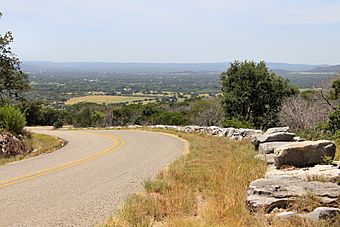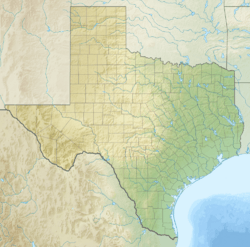Texas Park Road 4 facts for kids
Quick facts for kids
Park Road 4 |
||||
|---|---|---|---|---|
|
PR 4 highlighted in red
|
||||
| Route information | ||||
| Maintained by TxDOT | ||||
| Length | 15.500 mi (24.945 km) | |||
| Existed | June 22, 1937–present | |||
| Major junctions | ||||
| West end | ||||
| East end | ||||
| Location | ||||
| Counties: | Burnet | |||
| Highway system | ||||
| Highways in Texas Interstate • U.S. • TX (Loops – Spurs – Rec – FM)
|
||||
|
Park Road 4 Historic District
|
||||

Park Road 4 as it descends into Hoover's Valley.
|
||||
| Location | PR 4 from US 281 to SH 29 & Longhorn Cavern State Park | |||
| Area | 953 acres (386 ha) | |||
| Built | 1934-1942 | |||
| Architect | Merrill E. DeLonge, et al. | |||
| NRHP reference No. | 10001221 | |||
| Significant dates | ||||
| Added to NRHP | February 7, 2011 | |||
Park Road 4 (or PR 4) is a special road in Texas. It is about 15.5 miles (24.9 km) long. This road helps people get to two cool places: Longhorn Cavern State Park and Inks Lake State Park. It connects State Highway 29 (SH 29) to U.S. Route 281 (US 281).
The road was built a long time ago, between 1934 and 1942. It was built by groups like the Civilian Conservation Corps (CCC) and the Works Progress Administration (WPA). These groups helped people find jobs during a tough time in history.
Contents
Exploring Park Road 4
PR 4 starts near a place called Buchanan Dam. From there, it goes east right through Inks Lake State Park. Imagine driving through a park!
The road then climbs up about 400 feet (120 m) from Hoover's Valley. After that, it goes through Longhorn Cavern State Park. Finally, it ends at US 281, which is south of the town of Burnet.
How Park Road 4 Was Built
The first part of PR 4 was built in the mid-1930s by the Civilian Conservation Corps (CCC). The CCC was a program that gave young men jobs during the Great Depression. They built this part of the road so visitors could easily get to the new Longhorn Cavern State Park.
Later, in the early 1940s, workers from the Works Progress Administration (WPA) extended the road. The WPA was another program that created jobs. They helped finish the road when Inks Lake State Park was being built around 1942.
Special Features Built by the CCC
The CCC and the Texas State Highway Department worked together to add many cool features to PR 4 between 1934 and 1942. They built:
- Stone entrance gates
- Bridges made of stone
- Walls to hold back the earth
- Two special spots where you can stop and enjoy the view
- Drains under the road
- Stone guard walls for safety
The CCC also made sure to protect the large live oak trees and other plants while building the road. They even planted more native trees and plants in three spots along the road: at the entrance, near Longhorn Cavern, and at one of the overlooks.
A Historic Road and Park
Because of its special history and how it was built, all of PR 4 and Longhorn Cavern State Park were added to the National Register of Historic Places on February 7, 2011. This means they are important places that should be protected.
Longhorn Cavern itself was named a National Natural Landmark in 1971. This means it's a very special natural place. Also, a building along the road, which was once the park's office, was named a Recorded Texas Historic Landmark in 1989.




